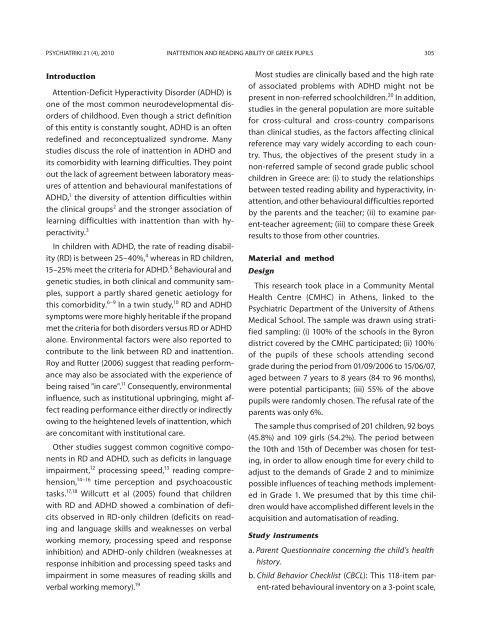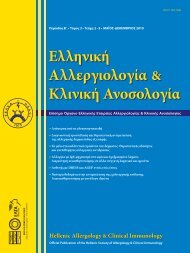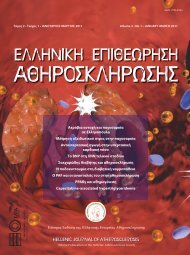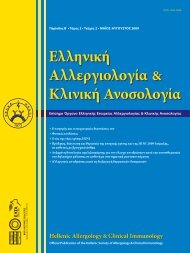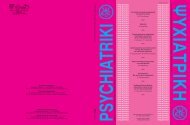ÏÏ ÏιαÏÏικη - ÎÎΤΠÎαÏÏικÎÏ ÎκδÏÏειÏ
ÏÏ ÏιαÏÏικη - ÎÎΤΠÎαÏÏικÎÏ ÎκδÏÏειÏ
ÏÏ ÏιαÏÏικη - ÎÎΤΠÎαÏÏικÎÏ ÎκδÏÏειÏ
- No tags were found...
Create successful ePaper yourself
Turn your PDF publications into a flip-book with our unique Google optimized e-Paper software.
PSYCHIATRIKI 21 (4), 2010 INATTENTION AND READING ABILITY OF GREEK PUPILS 305IntroductionAttention-Deficit Hyperactivity Disorder (ADHD) isone of the most common neurodevelopmental disordersof childhood. Even though a strict definitionof this entity is constantly sought, ADHD is an oftenredefined and reconceptualized syndrome. Manystudies discuss the role of inattention in ADHD andits comorbidity with learning difficulties. They pointout the lack of agreement between laboratory measuresof attention and behavioural manifestations ofADHD, 1 the diversity of attention difficulties withinthe clinical groups 2 and the stronger association oflearning difficulties with inattention than with hyperactivity.3In children with ADHD, the rate of reading disability(RD) is between 25–40%, 4 whereas in RD children,15–25% meet the criteria for ADHD. 5 Behavioural andgenetic studies, in both clinical and community samples,support a partly shared genetic aetiology forthis comorbidity. 6–9 In a twin study, 10 RD and ADHDsymptoms were more highly heritable if the propandmet the criteria for both disorders versus RD or ADHDalone. Environmental factors were also reported tocontribute to the link between RD and inattention.Roy and Rutter (2006) suggest that reading performancemay also be associated with the experience ofbeing raised "in care". 11 Consequently, environmentalinfluence, such as institutional upbringing, might affectreading performance either directly or indirectlyowing to the heightened levels of inattention, whichare concomitant with institutional care.Other studies suggest common cognitive componentsin RD and ADHD, such as deficits in languageimpairment, 12 processing speed, 13 reading comprehension,14–16 time perception and psychoacoustictasks. 17,18 Willcutt et al (2005) found that childrenwith RD and ADHD showed a combination of deficitsobserved in RD-only children (deficits on readingand language skills and weaknesses on verbalworking memory, processing speed and responseinhibition) and ADHD-only children (weaknesses atresponse inhibition and processing speed tasks andimpairment in some measures of reading skills andverbal working memory). 19Most studies are clinically based and the high rateof associated problems with ADHD might not bepresent in non-referred schoolchildren. 20 In addition,studies in the general population are more suitablefor cross-cultural and cross-country comparisonsthan clinical studies, as the factors affecting clinicalreference may vary widely according to each country.Thus, the objectives of the present study in anon-referred sample of second grade public schoolchildren in Greece are: (i) to study the relationshipsbetween tested reading ability and hyperactivity, inattention,and other behavioural difficulties reportedby the parents and the teacher; (ii) to examine parent-teacheragreement; (iii) to compare these Greekresults to those from other countries.Material and methodDesignThis research took place in a Community MentalHealth Centre (CMHC) in Athens, linked to thePsychiatric Department of the University of AthensMedical School. The sample was drawn using stratifiedsampling: (i) 100% of the schools in the Byrondistrict covered by the CMHC participated; (ii) 100%of the pupils of these schools attending secondgrade during the period from 01/09/2006 to 15/06/07,aged between 7 years to 8 years (84 το 96 months),were potential participants; (iii) 55% of the abovepupils were randomly chosen. The refusal rate of theparents was only 6%.The sample thus comprised of 201 children, 92 boys(45.8%) and 109 girls (54.2%). The period betweenthe 10th and 15th of December was chosen for testing,in order to allow enough time for every child toadjust to the demands of Grade 2 and to minimizepossible influences of teaching methods implementedin Grade 1. We presumed that by this time childrenwould have accomplished different levels in theacquisition and automatisation of reading.Study instrumentsa. Parent Questionnaire concerning the child’s healthhistory.b. Child Behavior Checklist (CBCL): This 118-item parent-ratedbehavioural inventory on a 3-point scale,


